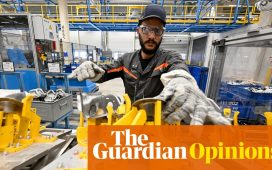In the decade following US President John F Kennedy’s 1961 announcement of America’s mission to put a man on the moon, the number of physical science PhDs tripled, and that of engineering PhDs quadrupled.
Now, the country is embarking on a moonshot to rebuild the semiconductor fabrication industry. Corporations that want a cut of the $39bn in manufacturing incentives within the Chips and Science Act programme can start filing their applications for subsidies on Tuesday. In order to get them, they’ll have to show that they are contributing to something that may be even more difficult than putting a man in space: building a 21st-century workforce.
America has plenty of four-year graduates with crushing debt (the national average for federal loan debts is more than $37,000 a student) and underwhelming job prospects. It also has plenty of college dropouts and young people with high-school degrees who are trying to make ends meet through minimum-wage jobs supplemented by gig work.
What it lacks are the machinists, carpenters, contractors and technicians who will build the new fabrication facilities. It also needs to triple the number of college graduates in semiconductor-related fields, such as engineering, over the next decade, according to commerce secretary Gina Raimondo.
Raimondo, who is well on her way to becoming the industrial strategy tsar of the administration, gave a speech to this effect earlier this month. In it, she underscored not only the need to rebuild chip manufacturing in a world in which the US and China will lead separate tech ecosystems, but also to ensure that there are enough domestic workers to do so.
“If you talk to the CEOs of companies like TSMC and Samsung [both of which are launching fabs in the US], they are worried about finding these people here,” Raimondo told me. She cites workforce development — alongside scale and transparency — as major hurdles that must be overcome to meet the administration’s goals.
The global chip manufacturing industry has tripled in the past 20 years, but the number of US workers in the industry has fallen by a third. This reflects the fact that America chose to focus not on chip making, but on the design of the intellectual property within the chips — otherwise known as “fabless” production.
But it also reflects something larger about how the country thinks about its economy, and about what constitutes a good education. As vocational programmes were downsized from the 1970s onwards (some liberals derided them as classist and or racist), and the industrial commons was outsourced as part of global trade liberalisation, the natural links between brain work and manual labour were broken.
High-end software engineers in Silicon Valley design chips. Minimum wage retail staff sell the gadgets that contain them. But in the US (unlike other rich nations such as Germany or Korea or Japan) too many of the well-paid technical and industrial jobs in between have been lost. These are exactly the skills America needs now to capitalise on the enormous federal money dump coming down the pike. Even before the chips act, the US was short of half a million construction workers.
This is one reason that trade programmes are booming. I recently spent time at the United Brotherhood of Carpenters and Joiners of America union training headquarters in Las Vegas, which was vast, sparkling and filled not only with the traditional union workforce, but also college graduates and mid-life professionals shifting careers. “We’ve found that people are increasingly coming to the skilled trades after they go to college,” says the union’s general president Douglas J McCarron. They are drawn both by the appeal of working with their hands and of having a clear path to retirement.
More diversity will be key to plugging the skills gap. As Raimondo noted in her speech, “we need another million women in construction over the next decade to meet the demand not just in chips, but in other industries and infrastructure projects as well.” Companies that want subsidies will have to prove on their applications that they are not only courting these workers, but working with educational institutions of all kinds, from universities and graduate programmes to community colleges and high schools, to create a workforce that is “job-ready on day one,” as the commerce secretary puts it.
That would include partnerships with the growing crop of “six in four-year” secondary schools that provide both a high school and two years of college credit. But they would also need to ensure that those with more advanced degrees are learning the most up-to-date and useful curriculums. The current mismatch between education and jobs in the US is well illustrated by the fact that humanities and arts PhDs carry far more debt (much of it state-subsidised) than those undertaken by Stem graduates — and many of the former will be underemployed.
Thankfully, the silos within the American education system are starting to break down. Some high schools are now teaching college curriculums. Union members are learning not just trades but soft skills, leadership and management. High-fee universities are under pressure to prove they also offer a pathway to economic success. If America is lucky, the manufacturing moonshot may catalyse more of these much-needed changes in education.






